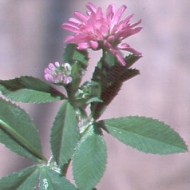
Persian clover
| Name: | Persian Clover (Trifolium resupinatum) |
||||||||||||||||||||||||||||||||||||||||||||||||||||||||||||
|---|---|---|---|---|---|---|---|---|---|---|---|---|---|---|---|---|---|---|---|---|---|---|---|---|---|---|---|---|---|---|---|---|---|---|---|---|---|---|---|---|---|---|---|---|---|---|---|---|---|---|---|---|---|---|---|---|---|---|---|---|---|
| Description: | An autumn and winter spring growing annual with excellent tolerance to waterlogging. Persian clover is moderately tolerant of salinity being superior to subterranean clover but inferior to lucerne in that respect. Used as a fodder/forage crop; good feed value as hay, pasture or standing hay. Also used as a component in high-density legume crops in cropping rotations. Good regrowth after grazing. It is suitable in mixtures with short-term ryegrasses. Sow in mid-late autumn (dryland) or early February (irrigated). Sowing rate: 4–10 kg/ha. There are 2 types of Persian clover: Trifolium resupinatum var. resupinatum has a more prostrate habit, thinner stems and smaller leaflets. Used in dryland pastures. Hard seed and seed yields are higher than majus. Flowering and maturity are mostly earlier than majus types. Minimum average annual rainfall for this group of Persian clovers is 450 mm (Southern NSW). Inoculant Group O. Trifolium resupinatum var. majus has an erect habit, thick hollow stems and large leaflets. Hard seed level is very low at one to two per cent. Flowering and maturity is mostly late. Used in high density legume crops. Minimum average annual rainfall for this group of Persian clovers is 450 mm (Southern NSW). |
||||||||||||||||||||||||||||||||||||||||||||||||||||||||||||
| Sowing rate: | 4-10 kg/ha. Inoculant Group O | ||||||||||||||||||||||||||||||||||||||||||||||||||||||||||||
| Minimum average annual rainfall: |
450 mm (Southern NSW). | ||||||||||||||||||||||||||||||||||||||||||||||||||||||||||||
| Select varieties on the basis of: | Use pattern: Short-term or medium to long-term pasture or high density annual forage as outlined above. Maturity: Later maturing varieties for irrigation and high rainfall. Hard seed levels: Higher hard seed levels confer better regeneration potential. Use soft seeded varieties with no or low hard seed levels for annual forage crop, those with high hard seed levels for self-regenerating pastures. Seasonal production: Select varieties to match feed requirements (check local trial information if available). Disease resistance: Varieties differ in their resistance to disease. Check local information on the need to have resistance in varieties. Of importance is leaf and stem rust, clover scorch and phytophthora root rot. |
||||||||||||||||||||||||||||||||||||||||||||||||||||||||||||
| Seed available: |
|
||||||||||||||||||||||||||||||||||||||||||||||||||||||||||||


